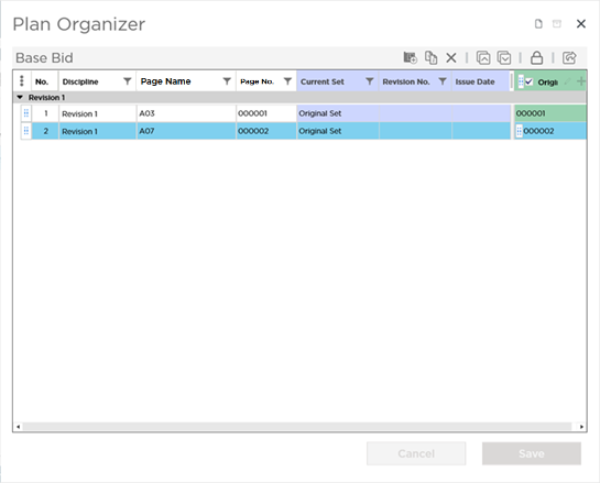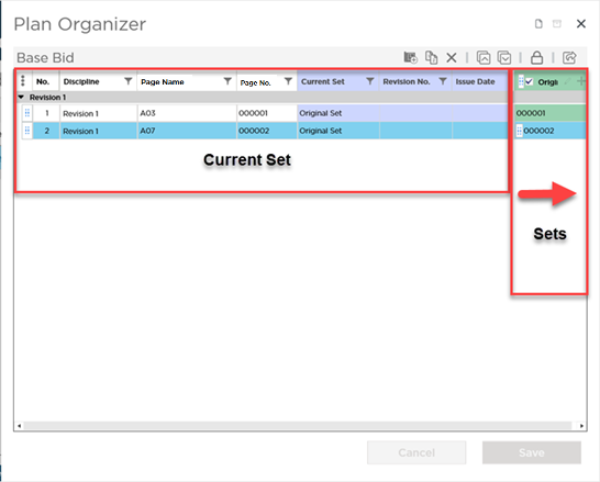In the previous chapter, we briefly introduced you to the Plan Organizer so you could add an initial set of plans (a Plan Set) to your new project. In this chapter, we dive into detail about the Plan Organizer, the Plan Set Editor, and using these tools to upload, organize, and manage the plans used in a project.
Each article in this chapter builds on and expands upon the previous article or articles, so we recommend reviewing this chapter "in order". Understanding the Plan Organizer and the concepts of plans, plant sets, active sets, and revisions is important to using, well, the rest of the product. There really is not a lot you can do with ConstructConnect Takeoff if you do not add and organize your plans properly.
By the end of this Chapter, you should understand how to use the
Plan Organizer, what is meant by a
Page, a
Plan, a
Plan Set, and how to leverage the
Plan Organizer to make your
project plans easy and more efficient to navigate and use.
If you are using a
Project Intelligence
project, there is a lot less you do in the
Plan Organizer, and you can come back to this Chapter as a reference if you have to create a
project manually. Adding
Revision Plan Sets, naming Pages, and other
plan management tasks are handled for you as part of the
Project Intelligence platform.
As its name implies, the Plan Organizer is a utility that helps you upload and organize the various Plan Sets that you use along the course of getting your pre-construction estimate ready all the way through turning over the proverbial keys to the owner. You may only load one Plan Set in any given project or hundreds, it all depends on the scope and scale of the project. The number or alternates bids and change orders created during and after the bidding phase also affects the number of plan sets in any project.
A normal project probably includes several Plan Sets (issues, versions, etc.) of the building plans over the life of the project. Usually, managing all those different sets of plans for a project is an arduous chore and it can be difficult to identify what has changed between revisions of a Plan. ConstructConnect Takeoff makes it easy to manage these revisions and allows you to match up new revisions to existing plans. Once matched, the revisions become different views of the same plan. After your revisions are matched, you can use the Overlay function to compare different versions of a plan to see what has changed. You also can compare different Disciplines (such as floor plans and mechanical plans) to detect 'collisions'. We cover Revisions and Overlays in Related Articles and do not cover them in detail in this Chapter. What we want you to learn is how to use the Plan Organizer and Plan Set Editor to add and manage Plan Sets and Pages and once you've masted that, we will cover more advanced plan organization and set management - see Related Articles if you cannot wait.
When you add Plan Sets, the most current, active version of each Plan is called the "Current Set". The Current Set always shows you the most recent, active version of the Plan for each Page in your project. We cover Plan Sets in detail in the articles that follow, and show you how to setup your Pages so that you, and anyone collaborating on the project with you, can access plans and their many revisions easily and efficiently.
As you add Revision Sets, the make-up of the "Current Set" changes - some Pages will be represented in each Plan Set, others may not. Not every Page's Plan will be included in every Plan Set, nor does every Plan Set have to be "active" in every Bid where that Plan Set is available, however, the "Current Set" will always be most recently added and active revision of the Plan for each Page.
- When you create a Takeoff project, you must upload at least one Plan Set (this is why the Plan Organizer opens automatically the first time you save a project).
- If you are accessing a Project Intelligence project, your Plan Sets and Revisions are added and matched automatically, the only thing you have to do is update disciplines and Page Names, solely for your reference.
- Revisions (addition Plan Sets) and Overlays (comparing Revisions), is covered in Chapter 11 - we want you to be comfortable with the Plan Organizer and the Takeoff Tab before we get into advanced concepts.
- If you are adding an additional Bid to an existing Project, you need to make at least one Plan Set active. Activating a Plan Set creates the Pages on which you view Plans and draw Takeoff (measurements) and Annotations (markups).
Plan Organizer
You open the Plan Organizer by clicking the little drawer button  button next to a Bid's name in the Projects and Bids List.
button next to a Bid's name in the Projects and Bids List.

Although we covered this earlier, let us clarify a few terms used in the Plan Organizer:
- Page - this is an electronic "container" of sorts, accessed on the Takeoff Tab where an electronic representation of a construction Plan is displayed. The Page contains the Plan (the drawing or sheet - the electronic image of the blueprint) including the original and all revisions, all Takeoff objects, and all Annotations (drawing markups).
- Page Name is the name you give the Page based on the Title Block of the Plan (for example, "First Floor Plan" or "Reflected Ceiling Plan" or "Mechanicals Details").
- Page No. is assigned sequentially when you load a Plan Set, however you should change this to match the actual plan (typically "A" for Architecture, "C" for Civil, "L" for Landscape, etc. followed by some additional sheet designation - A2.31; M210, etc.). You use the Page No. to match revisions of a plan with older releases. We cover Revisions and Matching in Related Articles. By default, the Page No. is shown in the Page Navigator, you can turn it off in Settings.
- We recommend that you update Page Name and Page No. to make navigation and matching easier.
- Page Index Number - this is the number of the row in the Plan Organizer that uniquely identifies this Page. It is shown in the Page Navigator by default, you can turn it off in Settings.
We avoid using the term "drawing" when referring to the
Page (or
plan or
sheet) - we reserve 'drawing' for what you do with a
Takeoff Item - you
draw takeoff.
The Plan Organizer is composed of two regions:
- The Current Set Detail which describes every Page in the project and indicates which Revision comprises this Current Set. The most current, active revision of a Plan is what is in the Current Set.
- If a Page does not have a Plan referenced in the "Current Set" column, that Page does not exist in this bid - not every Plan Set has to be active in every bid, we cover this later in this Related Articles.
- The Revision history which shows every Set in the Project.

Sets can be "Active" or "Inactive" meaning the check box next to the Set Name in Plan Organizer is either checked or not, which we cover later in this chapter.
Before we go any further, we need to explain the Current Set and how Plan Sets are shared between Bids within the same Project. It is critical that you understand how the Current Set is built and that changes made to the Plan Organizer affect all Bids that are created within a Project, not just the Bid from which you opened the Plan Organizer. So, without further delay, the Current Set explained in detail...

 button next to a Bid's name in the Projects and Bids List.
button next to a Bid's name in the Projects and Bids List.

 What are Plans, Plan Sets, and Revisions?
What are Plans, Plan Sets, and Revisions?